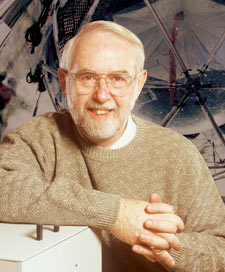
Born in Sydney, Nova Scotia, McDonald earned his undergraduate (1964) and master's degrees (1965) in physics from Dalhousie University in Halifax. He graduated from Cal Tech with his Ph.D. in nuclear physics in 1969. He worked on nuclear physics experiments at the Chalk River Nuclear Laboratories of Atomic Energy of Canada until 1982, when he became a professor at Princeton. In 1989 he moved back to Canada to teach at Queen's University and to direct the Sudbury Neutrino Observatory (SNO).
SNO was a giant neutrino detector built in a nickel mine in Ontario, two kilometers beneath the surface, for the purpose of tackling the solar neutrino problem. The original attack on the Standard Model came when earlier neutrino detectors - including the Super-Kamiokande, a giant neutrino detector in Japan, overseen by fellow Benjamin Franklin Medal winner Yoji Totsuka—spotted only one third to one half of the predicted electron neutrinos. The data suggested that as these particles flew toward our planet at the speed of light, they turned into other types of neutrinos--particles such as muon and tau neutrinos—which were nearly invisible in most neutrino detectors when produced at low energy in the Sun.
But SNO could spot all the neutrinos. While low-energy solar electron neutrinos sometimes hit an electron attached to a molecule of ordinary water, as in previous neutrino detectors, all neutrinos, including muon and tau neutrinos, can be spotted much more easily when they bump into a deuterium nucleus, so McDonald's team filled their detector with $300 million worth of what is known as "heavy water"—water with molecules made of deuterium instead of hydrogen. Because they were the first to be able to directly count how many of each neutrino they found, the SNO researchers found solid evidence that electron neutrinos did indeed change into tau and muon neutrinos and back again during their eight minute journey from the sun. Supporting this, the Super-Kamiokande detector showed that higher energy astmospheric neutrinos, that is neutrinos formed in the earth's atmosphere by cosmic rays, also oscillated, with muon neutrinos disappearing into difficult-to-detect tau neutrinos. Together, their results bored the first ever hole into the previously-unbreakable Standard Model.
McDonald is the author of more than 120 papers and his awards include: the Bonner Prize of the American Physical Society (2003), the Canadian Association of Physicists Medal for Lifetime Achievement in Physics (2003), the Gerhard Herzberg Canada Gold Medal for Science and Engineering (2003), the Sigma Xi Fund of Canada Award for Scientific Achievement (2004), and the Bruno Pontecorvo Prize in Particle Physics (2005).
Today, McDonald has a part in trying to fund SNOLAB, a new detector to search for another nearly invisible particle: the WIMP. These are hypothetical—no one has ever detected one—but if found they might represent the missing mass that scientists think is in the universe but have yet to spot.
Information as of April 2007

